My 19th Century Custom Quarantine Project!
 mouschi
Posts: 697 ✭✭✭✭
mouschi
Posts: 697 ✭✭✭✭
My 19th Century Quarantine Project!
First, I'll give it to you short and sweet. If you want to read the entire article, keep scrolling, but if you don't care about the labor pains and just want to see the baby, here you go!
I was alerted to an Iowa find that unearthed an 1889 Goodwin A35 Round Album - each Round has more in common with baseball cards than they do album pages. They are considered to be the most premium baseball issue to come out of the 19th century and had been lost to the hobby for about 130 years! Typically sold as singles, the A35 Rounds rarely make it to market. I have been looking to add some to my collection, because I LOVE 19th century color lithography. The Iowa find came to market and I WON THEM! Here is a pic:

They are huge. Check out the sizing.

Simply putting each in holders wasn't doing them any favors aesthetically (this is just a cheap computer print out) ...

...so to standardize them, I spent the last few months inventing, designing, and constructing a new screwless holder with a slide out tray for each Round. Think: Allen & Ginter rat bone or tarantula ... but with 19th century lithography! Here are some examples of Topps doing it (though, Topps doesn't have pull out trays ... these are permanent):

The artwork I designed was printed on the back side of acrylic, so it gives it a deep, rich, high end feel.

The top of the inserted tray that slides in has a lip, so it seals off the top flush with the edge. The best of both worlds - an entirely new collectible with an embedded 19th century art relic that isn't just a frame, but it also isn't permanent!
Here is one of the singles. Each piece is 5/8" thick!

and the back. It is like a massive, jumbo Allen & Ginter back, but with the Old Judge mascot.

Here is another. The artist of the 1888 N162 Goodwin created a stormy background to match King Kelly's personality, so I did the same.
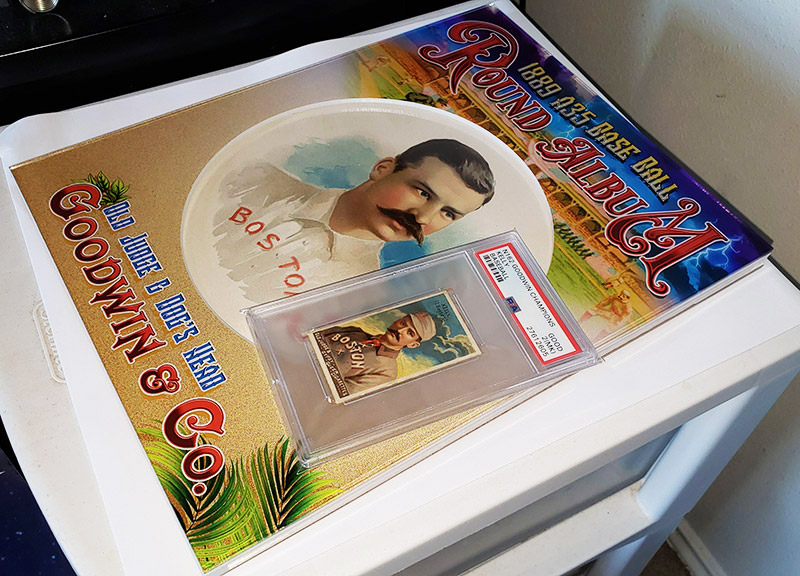
And now, for the full story ... lots more words and lots more pictures if you are interested ...
The Day Baseball Cards Died
Our beloved hobby began largely in the mid-late 1880's. Kids were WILD about baseball cards. Baseball card production ended (aside from a few sets) in January of 1890 when the ATC (American Tobacco Company) formed, removing any reason for cigarette companies to advertise. It wouldn't be until about 20 years later when the ATC was broken up and baseball cards were regularly produced again, ushering in cards like the T206 set.

In a matter of months prior to the end of baseball cards in 1889, Goodwin offered up a buzzer beater with the 19th century's most premium baseball issue: The 1889 Goodwin A35 Round Album. It is as if the creators of 19th century baseball cards said "Let's go out with a bang and make something really special. Something that will blow everyone away." In spite of their beauty and rarity, it is quite possible that you may have never even heard of them before.
Introducing: the 1889 Goodwin A35 Round Album
The 1889 Goodwin A35 Round Album features a bound set of Rounds depicting either one or four players in beautifully detailed full color lithography, with stats on the back. In spite of the moniker, they have more in common with baseball cards than they do albums. Originally offered as a redemption for a whopping 75 coupons as opposed to their tiny cigarette card counterparts that came in each pack of cigarettes, it is no wonder why they are so rare and why many simply have never heard of these beauties before. Whenever they come up for auction, they are oftentimes sold as singles.
Each round is 8.25 inches in diameter, dwarfing cigarette cards, standard issue cards today and even the premium cabinet cards offered in the 19th century. The splash of color on a stark white background may remind you of Allen & Ginter cards.

When these were made, surely the creators had to pick each one up when finished to marvel at their beauty. True, pure, art worthy of framing. (You did read my article about how 19th century baseball cards were made, didn't you?)

The level of detail on each is incredible. Looking up close, you can get a sense of the level of craftsmanship that went into each piece, and how much skill was needed from the hands of the artists and lithographers. It is no wonder why, in the 1930's, noted American printed ephemera collector Jefferson Burdick assigned a $10 value to it, making it one of the hobby's most valuable items at the time. This was when the T206 Honus Wagner was valued at an unheard of $50. It was highly sought after 50 or so years after its release, and to this day is still highly sought after, 130+ years later by those who know what they are.

Ever since I learned of them, I have kept an eye out for examples this year to purchase - the last pieces that sold on eBay were a pair that are glued to paper. In spite of the rough shape, their magnificence still shows through - this piece sold for $275. (I was not the buyer, as it wasn't quite what I was looking for.) Though they were sold as the A35 Rounds, it appears as though they were actually cut from an advertisement poster.

The Iowa Find
It is easy for me to get romantic about pre-war finds of baseball cards. One can daydream about searching an old bookstore, with books that haven't been touched in ages, where the previous owner tucked a tobacco card between the pages as a bookmark. Or perhaps finding an old, dilapidated house with all kinds of treasures in the attic.
Imagine opening a dusty chest to go through various artifacts that clearly had not been touched for a couple of lifetimes. The strong, musty smell of old newspaper and other paper relics instantly fill your nostrils. It is a chore carefully pulling everything out, and just before you give up, you see a full color portrait of a baseball player looking up at you - one that clearly looks like he predates Babe Ruth by decades - it is Cap Anson, and there are others bound to him as well!

I was alerted to a find in Iowa that unearthed an entire set of these. They were tucked away from the hobby for about 130 years! I'm not sure how they came about, but the set was sent to auction, and I watched closely. While several rounds had been torn near its binding hole, the lithography on each was crisp, bright and vibrant - just as they were when they came from the lithography studio in the 19th century. Many of these that come up for auction will show similar damage, as they were bound (quite literally) to be torn or bent from what bound them together. I decided to place a bid ... and won!
Creating Something Special
Featuring the World Champion New York Giants and loaded with prominent Hall of Famers, I wanted to do something special to display each one separately. They would look nice fanned out and framed like shown above, but it would be a crime to hide such beauties. Before they arrived, I went to work by creating paper prototypes and templates of holders, while printing out paper copies of the rounds to use as guinea pigs.

Here is what one would look like free floating in a plexiglass holder. The presentation leaves a lot to be desired.

When they came in, I already had a prototype of a frame in hand, created by Jeremy Skinner - eBay user hardball34. If you need a holder created, seriously ... he is your guy! Here is the prototype sleeve and holder measuring 9.5" x 12".

Here it is together. I made sure the hole minimized or completely hid the damage, so the focus was on the beautiful color lithography.

While the frame "standardizes" each behemoth Round as a rectangle to make it more palatable for collectors such as myself, it didn't capture exactly what I wanted. Not that they necessarily look bad like this - by themselves, they remind me of big, round, Allen & Ginter cards. Their beauty is in their craftsmanship, color, detail, and simplicity. Still, I had plans to create something completely new with them. In the past, Topps has created beautiful holders to transform otherwise mundane pieces as truly special collectibles. A spider or rat bone on a desk is gross. In their own custom holders like below? Awesome sauce!

Inventing a New Screwless Holder
Aside from the lack of graphic, the difference between the above and my prototype is that mine had screws, and that bothered me. I decided to attempt to create a screwless holder. I didn't want to encase each Round permanently though, so I reached out to some industry professionals with my ideas, and they said it couldn't be done - that I was asking for magic. I was up for the challenge, though, and started designing schematics for it - I love inventing new things!
The schematics I designed called for a built in tray, so I could affix each A35 Round to, allowing them to slide in and out of the holder. Doing this allowed me to do away with the screws, while having them enclosed as standalone pieces like the Allen & Ginters above. In my mind, removing the screws transformed this project from merely creating cool looking frames to developing an entirely new collectible, with amazing 19th century baseball artifacts embedded into them.
Jeremy cut the pieces I called for, and I assembled them. Here is the prototype showing a tray sliding in and out, without the need for screws. You will notice a "lip" at the top - that allows for the top of the entire piece to be flush, sealing it off, instead of having a huge gaping hole at the top. Most importantly - no screw holes!

After knowing the prototype was exactly how I wanted it, I had the other pieces cut and sent so I could create 12 of them, 1 for each Round:

Every. single. step. was challenging. I had to figure out how to get these pieces to stay together most effectively, so I ordered a plethora of adhesive solutions, with varying strengths.

The next challenge when putting these together was to line them up so they would be perfectly flush. A bracket was made by affixing acrylic corners to the backside of an old table I found in our garage ![]() Assembling the holders I designed was done over several hours while catching up on some TV shows. Each piece was an 8 step process.
Assembling the holders I designed was done over several hours while catching up on some TV shows. Each piece was an 8 step process.

Creating the Artwork
Perhaps the most challenging thing for me was to come up with complementary graphics to really set off each piece, and to make them each look like a professionally finished standalone piece. While it's easy to enhance a rat bone with the right graphics, it is much easier to detract from pieces that are already beautiful on their own.
I spent countless hours by staying up at night agonizing over colors, shades, font usage, wording, and more. Prototypes were created from some of these as well, and each time they were sent off, something wouldn't sit right with me, so I would dive back in and make more changes. It was a long, long process, but each revision looked better and better. Shown below are six of the eleventy-billion tests I created.

The baseball scene in the background was not selected just because it looked good. It was actually meant to pay homage to the Goodwin A36 album that was created so collectors could glue their 1888 Goodwin N162 cards in:

Eventually, I settled on this being the final design:

The actual graphics I designed are printed on the back side of 1/8" acrylic, which gives each piece a high end feel. Here are a few pictures of me trying to capture the feel of the acrylic. Pictures do these no justice, but hopefully you can get a feel for the depth that the acrylic gives them. The actual thickness of the finished pieces are 5/8".


Five of the rounds depict four players each, all of which are from the 1888 (and 1889) World Champion New York Giants. Featuring Hall of Famers such as Tim Keefe (2nd pitcher to get 300 wins), Buck Ewing (arguably the best catcher in the 19th century), Jim O'Rourke, Mickey Welch, John Ward and my favorite, Roger Connor.
All four of these guys are Hall of Famers ...

This shows you how each piece is not permanently encased. Each Round is sleeved, then affixed to a custom tray, with a lip at the top and bottom for a perfect fit. The top lip seals it off at the top so there isn't a gaping hole and it sits flush, without anything protruding. There is a little space on each side of the top tab however, to use a small hook to pull it out.

Gotta love the bowler hat ... and the kid as the mascot! The kid actually makes an appearance on an Old Judge card with Buck Ewing (player in the bottom left of the upper pic.)



Jim "Orator" O'Rourke, George "Piano Legs" Gore, and my favorite guy from all of these, the fellow in the bottom right. A player that is oftentimes overlooked and should be given much more credit. Our first ever Home Run King, Roger Connor.

For those of you who don't know who he is, let me introduce you to him!

In addition to the five rounds that highlight four players each, the 1889 Goodwin A35 Round Album also features four separate rounds featuring one player each. Cap Anson, King Kelly, Charles Comiskey and John Ward. The level of detail is astounding on them.
Charles Comiskey - best known for his time as the owner of the White Sox during the Black Sox scandal (and Comiskey Park being named after him) was also a good ball player, and a key person in forming the American League. Check out the book "Turning the Black Sox White" - great book and it talks a lot about him! Pictured below is his 1889 A35 Goodwin Round along with his 1888 Allen & Ginter card. (It says 1887 on the flip, but is widely considered an 1888 issue.)

John Montgomery Ward was another superstar at the time, and the lone player to get a solo Round in this set from the World Champion Giants. Pictured below is his 1889 A35 Goodwin Round with his 1888 Allen & Ginter card.

As a way to differentiate Anson and Kelly from the others, I did separate artwork for them, as a direct callback to what Goodwin did for them on their 1888 N162 Goodwin cards. The artist painted a sunset background for Anson to show that he was in the sunset of his career, and menacing clouds as a background for Kelly, because of his stormy personality. That is where I drew my inspiration from.
Here is the Anson shown with his 1888 N162 Goodwin (note the sunset) and 1888 N28 Allen & Ginter:
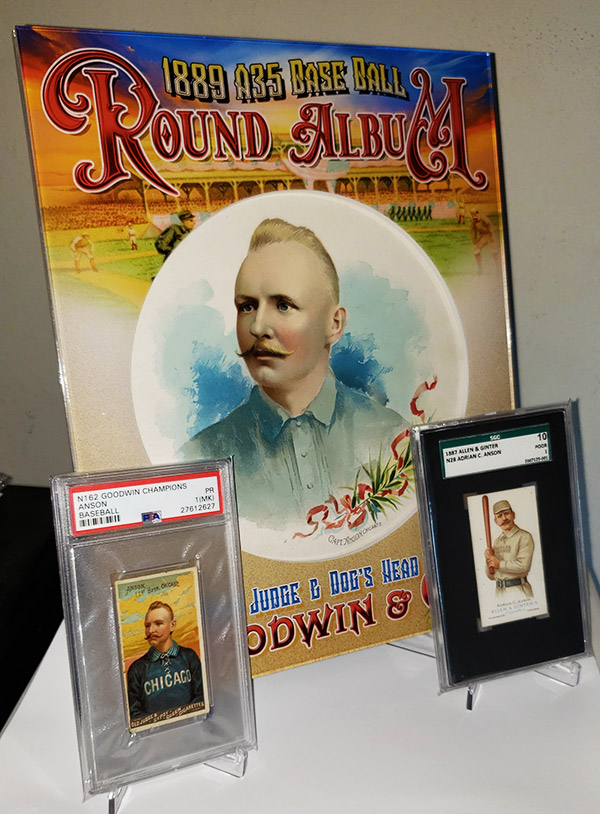
Here is the King Kelly displayed with his 1888 N162 Goodwin (note the stormy weather), 1887 N172 Old Judge Portrait and 1888 N28 Allen & Ginter:
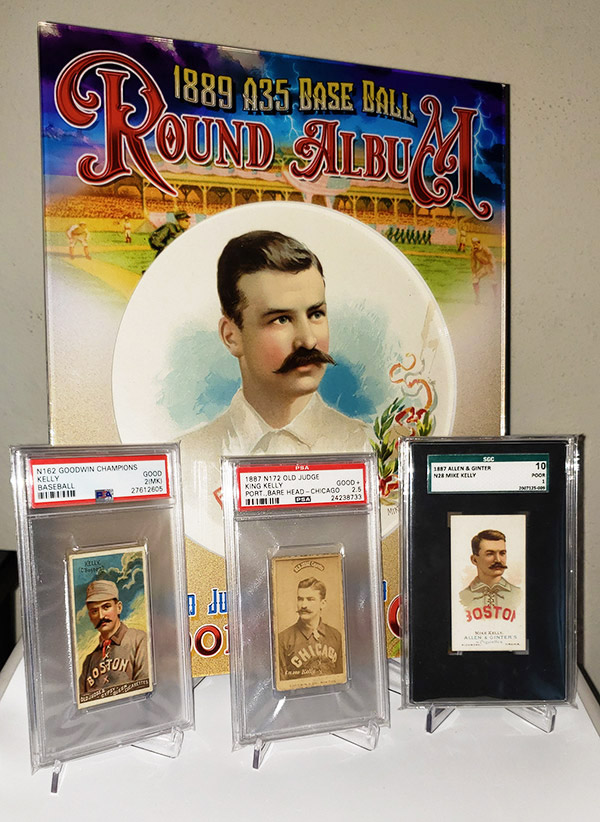
Even the advertisement got the custom treatment! Why not, right? It is beautiful full color lithography showing Old Judge, Dog's Head and Gypsy Queen. What's not to love?

The "covers" of the 1889 Goodwin A35 Round Album look like a baseball on the outside, but the artwork on the insides of them are much more interesting. The two mascot pieces were by far the worst conditioned pieces on the bunch, though the artwork remained largely unharmed. (Thankfully, these don't feature players!)

Yes, I did customize the two mascots. The middle piece above was on the reverse of the full color ad.
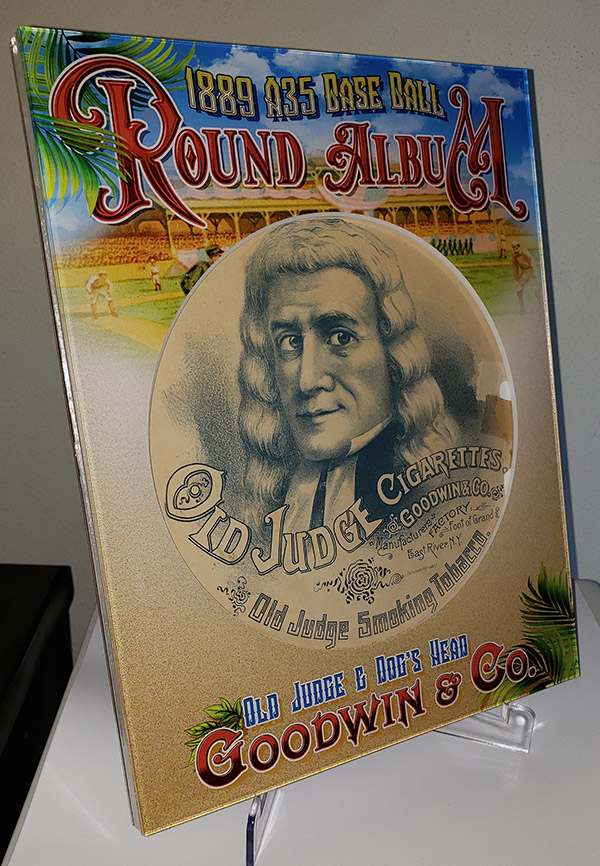

I fell head over heels in love with the Old Judge and Dog's Head mascots. They are amazing, and I had never seen them before! I scanned them in, cleaned them up, and incorporated my own artwork so I could use them as the backs. Think of them as huge, jumbo A&G...err...Goodwin mini backs. ![]()

Here are the final back pieces, printed directly on 1/8" acrylic.
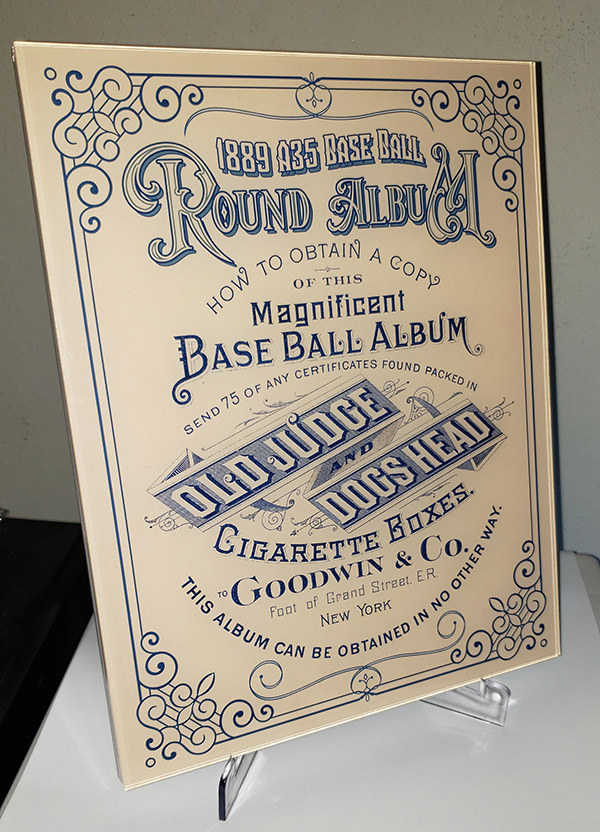


With as excited as I was about getting the A35 Round Album set itself, I'll admit that I was much more excited about putting together this massive project, and seeing its completion. I am exhausted, and went to bed nearly every night with it on my mind, going from the extreme of wrestling with thoughts of if this is all even worth it, to being jump-out-of-my-skin excited for it to be finished. Either way, it has certainly helped this COVID-19 Quarantine go by quicker, which has also afforded more more time to dedicate to this fun and challenging project.
The more I learn about 19th century baseball, the more I'm amazed and intrigued by its rich history. We will never be able to hear King Kelly's thick Irish accent, or see footage of Roger Connor hitting a home run. We don't even have much in the way of any photographs of players playing, much less any video footage or audio clips. I guess that is what makes it such a treat owning relics that baseball fans have fawned over for nearly 150 years.
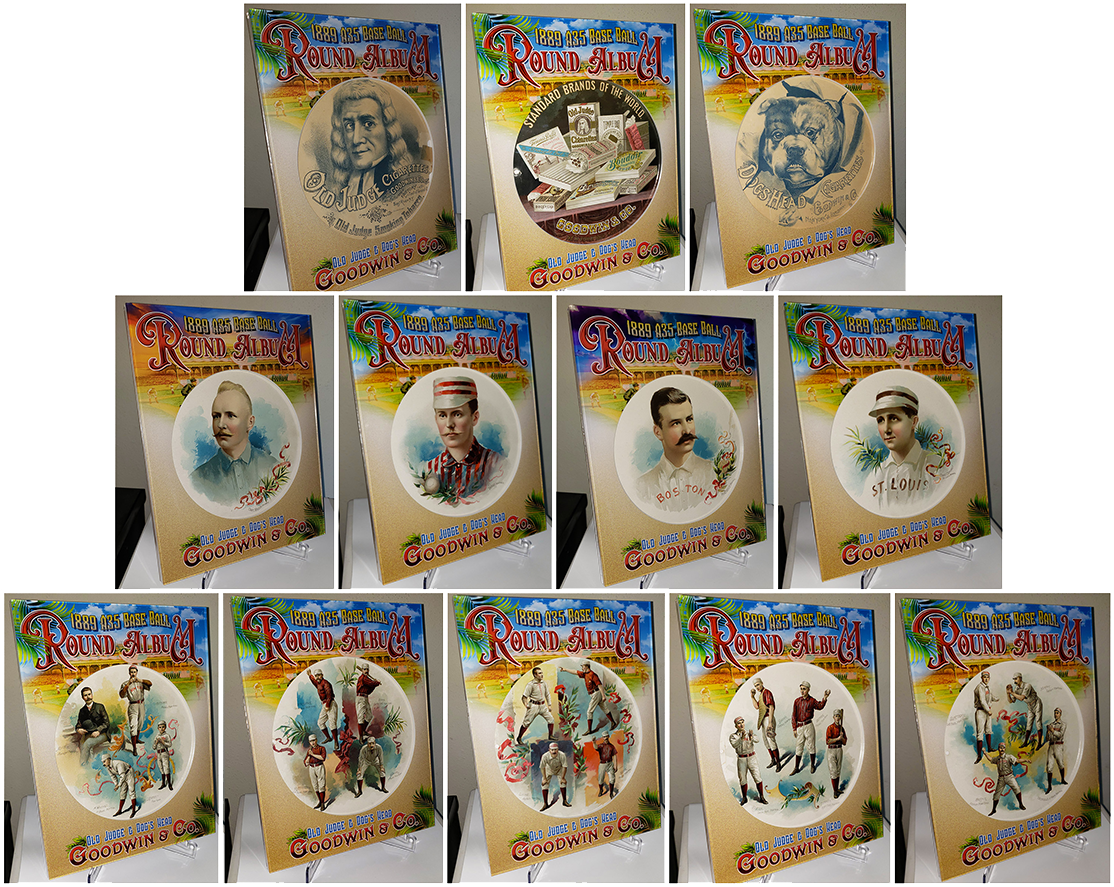

Comments
Wow, now that's what I call enjoying your collection!
And, yes, it was worth it.
Thank you CW! I was wondering if anyone on here cared
Not sure how I missed this one, Tanner.
Incredible work! You are very talented at what you do without question.
Thank you very much!
Those are great. Thanks for sharing.
Museum quality holders that truly bring out the beauty of each A35 Round. Admittedly, I know nothing about this era and set, but this was a great read that made me happy these landed in the right collection. Thanks for sharing!